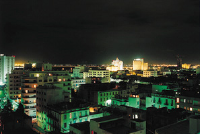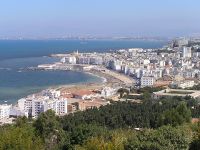Maghreb

The Maghreb (المغرب العربي al-Maġrib al-ʿArabī; also rendered Maghrib (or rarely Moghreb), meaning "place of set" or "western" in Arabic, is the region of Africa north of the Sahara Desert and west of the Nile — specifically, coinciding with the Atlas Mountains. Geopolitically, the area is reckoned to include Morocco, Western Sahara, Algeria, Tunisia, Libya, and sometimes Mauritania (which is often placed in West Africa instead) - put more simply, the member states of the Arab Maghreb Union plus the Western Sahara. An inhabitant or thing of the Maghreb is called a Maghrebian or Maghrebi.
Etymology
The word maghreb is an Arabic term literally meaning "place of setting (of the sun)", and hence "West." It derives from the root ghuroob, meaning "to set" or "to be hidden" (however, it is not used to refer to the setting of the moon). It is also used in a manner similar to the metaphorical use "to be eclipsed", which is used in English.
In Arabic but not in English, Al Maghreb commonly refers to Morocco: the full Arabic name of Morocco (Al Mamlakah al Maghribīyah) translates to "the Western Kingdom". Historically, Morocco was called Al Maghreb al Aqşá ("the Furthest West"). The English name comes from Marueccos an early Spanish pronounciation for Marrakesh.
Culture and roots
Maghrebis are of mixed origins. They are mainly of Berber and/or Arab origins; the resulting mix is sometimes (particularly in Mauritania) termed Moorish. The Trans-Saharan trade brought in numerous West Africans, whose average contribution to the population increases as one goes south. In the northern coastal towns, conversely, several waves of European immigrants have influenced the population - notably Moriscos, Spanish Muslims who fled the Reconquista, Turks who came over with the Ottoman Empire, and French, Italians, Spanish, and others captured by the corsairs. Jewish communities have historically been present in the older cities, and have contributed to the wider gene pool through conversion. In Algeria especially, a large European minority, the "pied noirs", immigrated under French colonial rule; the overwhelming majority of these, however, left immediately following independence.
Berber languages are almost exclusively spoken in the Maghreb, and were originally spoken throughout it. The Arabic dialects of the Maghreb share many common characteristics (like a first person singular present with n-) that set them apart from the dialects of the Middle East and most of Egypt. The Maghreb traditionally used a specifically western variant of the Arabic alphabet, notably distinguished by placing a dot underneath fa and a single one above qaf; this has largely gone out of use since the late twentieth century.
The Maghreb largely shares a common culinary tradition; indeed, it was jocularly defined by Habib Bourguiba as the part of North Africa where couscous is the staple food.
The region is almost entirely Muslim in religion, following the Sunni Maliki school, although small Ibadi communities remain in some areas. A strong tradition of venerating marabouts and saint's tombs is found throughout the region, still commemmorated by the proliferation of "Sidi"'s on any map of the region, though this tradition has substantially decreased over the twentieth century. A network of zaouias traditionally helped proliferate basic literacy and knowledge of Islam in rural regions.
The traditional city architecture of the region is exemplified by numerous casbahs, old towns with whitewashed walls, narrow streets, multi-storey apartments built of stone, wood, and mud.
History
From the end of the Ice Age, when the Sahara Desert dried up, contact between the Maghreb and sub-Saharan Africa was extremely limited by the difficulty in crossing the desert. This remained the case until after the time of the Arab expansion and the spread of Islam; even then, trans-Saharan trade was restricted to costly (but often profitable) caravan expeditions, trading such goods as salt, gold, ivory, and slaves.
Originally, the Maghreb was inhabited by "Caucasoid" Cro-Magnoids (Iberomaurusians) in the north and by "Black" peoples in the Sahara. Later, about 8000 B.C.E., there came from the east "Caucasoid" speakers of northern Afro-Asiatic languages such as Berber at least since the Capsian culture.
Many ports along the Maghreb coast were occupied by Phoenicians, particularly Carthaginians; with the defeat of Carthage, many of these ports naturally passed to Rome, and ultimately it took control of the entire Maghreb north of the Atlas Mountains, apart from some of the most mountainous regions like the Moroccan Rif.
The Arabs reached the Maghreb in early Umayyad times, but their control over it was quite weak, and various Islamic "heresies" such as the Ibadis and the Shia, adopted by some Berbers, quickly threw off Caliphal control in the name of their interpretations of Islam. The Arabic language became widespread only later, as a result of the invasion of the Banu Hilal (unleashed, ironically, by the Berber Fatimids in punishment for their Zirid clients' defection) in the 1100s. Throughout this period, the Maghreb fluctuated between occasional unity (as under the Almohads, and briefly under the Hafsids) and more commonly division into three states roughly corresponding to modern Morocco, western Algeria, and eastern Algeria and Tunisia.
After the Middle Ages, the area east of Morocco was loosely under the control of the Ottoman Empire. After the 19th century, it was colonized by France, Spain and later Italy.
Today over two and a half million Maghrebins live in France, especially from Algeria, as well as many more French of Maghrebin origin.
Maghribi traders in Jewish history
In the tenth century, as the social and political environment in Baghdad became increasingly hostile to Jews, many Jewish traders there left for the Maghrib, Tunisia in particular. Over the following two (three?) centuries, a distinctive social group of traders throughout the Mediterranean World became known as the Maghribis, passing on this identification from father to son.
Source: Avner Greif, "Contract Enforceability and Economic Institutions in Early Trade: The Maghribi Traders' Coalition," American Economic Review 82: 128 (1994).
Modern territories of the Maghreb
- Algeria
- Ceuta (a city in Spain)
- Libya
- Mauritania
- Melilla (a city in Spain)
- Morocco
- Tunisia
- Western Sahara
Medieval regions of the Maghreb
- Ifriqiya
- Djerid
- Sus/Sousse
- Zab
- Hodna
- Rif
- Maghreb al-Awsat (Central Maghreb)
- Morocco (Maghreb al-Aqsa)
- Tamesna
- Tripolitania
See also
- Arab Maghreb Union
- Barbary Coast
- Berber
- Moors
- History of Algeria
- Maghreb toponymy
- North Africa
- Tamazgha
- Mashreq
- Northwest Africa
- Maghrebi script
- Jews of the Bilad el-Sudan (West Africa)
- African Jew
| Regions of the world | |||||||||||||||||||||||||
|---|---|---|---|---|---|---|---|---|---|---|---|---|---|---|---|---|---|---|---|---|---|---|---|---|---|
|
| ||||||||||||||||||||||||
| See also Continents of the world | |||||||||||||||||||||||||
Links
ar:مغرب عربي bg:Магреб ca:Magrib cs:Maghreb cy:Maghreb da:Maghreb de:Maghreb es:Mágreb eo:Magrebo fr:Maghreb gl:Maghreb hr:Magreb is:Magreb it:Maghreb he:מגרב lt:Magribas hu:Magreb nl:Maghreb ja:マグリブ no:Maghreb pl:Maghreb pt:Magrebe ru:Магриб sl:Magreb sr:Магреб fi:Maghreb sv:Maghreb tr:Magrip
